Compression Dewatering Forming: A Rheology-Driven Approach to Produce Complex-Shaped Prefabricated Cement Products
Abstract
1. Introduction
2. Materials and Production Process
2.1. Materials
2.2. Compression Dewatering Forming Process
3. Results and Discussion
3.1. Experiments on the Rheological Properties
3.1.1. Rheological Test Method Selection
3.1.2. Effect of Mortar Design Ratios on Rheological Properties
- When the dosage is less than 30%, fly ash significantly reduces the yield stress and plastic viscosity through the “ball bearing effect”, improving fluidity of the fresh mortar.
- The best rheology of the fresh mortar was achieved with the addition of 15% fly ash and silica fume due to the filling effect.
- The recommended mix proportion is 15% fly ash, 15% silica fume, 1.5% water-reducing agent, and 0.06% viscosity-reducing agent, which can effectively reduce surface defects and support the efficient production of complex shaped precast components, such as heated suspended floors.
3.2. Study of the Relationship Between Rheology and Formability
- Lack of material incompleteness: Visible voids or missing regions resulting from insufficient mold filling.
- Surface cracking: Irregular tortoiseshell-like fracture patterns.
- Surface pitting: Localized roughness and micro-depressions.
3.3. Effect of Compression Dewatering on the Compressive Strength of Mortar
3.3.1. Experimental Method for Compressive Strength
3.3.2. Effect of Press Dewatering on Compressive Strength
3.4. Mechanism of Micro-Action of Compression Dewatering on Mortar
3.4.1. Test Methods of Low Field Nuclear Magnetic Resonance
3.4.2. Effect of Press Dewatering on Moisture Migration
3.4.3. Effect of Compression Dewatering on the Porosity of Mortar
3.4.4. Effect of Compression Dewatering on the Pore Structure of Hardened Mortar
3.4.5. Analysis of the Relationship Between the Compressive Strength and Microscopic Properties of the Mortar
4. Conclusions
Author Contributions
Funding
Institutional Review Board Statement
Informed Consent Statement
Data Availability Statement
Acknowledgments
Conflicts of Interest
References
- Qiao, L.D. Firmly establish a new development concept to innovate and improve the development mode to push China’s building materials industry to a new era of high-quality development in a comprehensive way (above)—Report on the work of the Fifth Ninth Council of the China Building Materials Federation (Expanded Presidential Meeting). Compos. Mater. Sci. Eng. 2020, 2, 122–128. [Google Scholar]
- Su, W.H. On assembly floor system raised floor. Modul. China Constr. 2023, 9, 140–142. [Google Scholar]
- Huang, K.; Shi, Y.G.; He, Y.; Xia, J.L.; Z, Y.X.; Liu, J.; Zhang, X.C. A review of research on modeling process of dry-hard concrete products. Concr. Cem. Prod. 2018, 5, 45–47. [Google Scholar] [CrossRef]
- Eskandari-Naddaf, H.; Azimi-Pour, M. Performance evaluation of dry-pressed concrete curbs with variable cement grades by using Taguchi method. J. Ain Shams Eng. 2018, 9, 1357–1364. [Google Scholar] [CrossRef]
- Xu, Z.M.; Wang, Q. Design and experimental research on new imitation granite concrete curb forming device. Concr. Cem. Prod. 2019, 12, 83–86. [Google Scholar]
- Cheng, G.; Wang, Q. New process of pressing and modeling roadside stone. Sci. Technol. Innov. Appl. 2020, 24, 29–31. [Google Scholar]
- Ouyang, Y.L.; Fu, Y.M.; Qian, W.X.; Chen, S.X. Application of vacuum dewatering process in harbour concrete. Pearl River Water Transp. 2022, 2, 85–88. [Google Scholar]
- Yao, W.F. Research on the application of concrete vacuum treatment technology in road construction. Sci. Innov. 2017, 18, 154–155. [Google Scholar]
- Wang, C. Application of vacuum grouting technology in the construction of prestressed concrete bridges. Sichuan Build. Mater. 2024, 50, 81–83. [Google Scholar]
- EN B S. 197-1; Cement-Part 1: Composition, Specifications and Conformity Criteria for Common Cements. European Committee For Standardisation: London, UK, 2011.
- JGJ/T 70-2009; Standard Test Methods for Basic Properties of Building Mortar. Ministry of Housing and Urban-Rural Development: Beijing, China, 2009.
- GB/T 2419-2005; Method for Determining the Flowability of Cement-Based Sand. Ministry of Housing and Urban-Rural Development: Beijing, China, 2005.
- RISN-TG008-2010; Technical Guideline for Ordinary Construction Mortar. Ministry of Housing and Urban-Rural Development: Beijing, China, 2010.
- Liu, Y.; Shi, C.; Jiao, D.; An, X. Research progress on rheological properties, modelling and testing of freshly mixed cement-based materials. J. Silic. 2017, 45, 708–716. [Google Scholar]
- Li, M.; Han, J.; Zhou, Y. A rheological model for evaluating the behaviour of shear thickening of highly flowable mortar. Molecules 2021, 26, 1011. [Google Scholar]
- Feys, D.; Wallevik, E.; Yahia, A. Extension of the Reiner-Riwlin equation to determine modified Bingham parameters measured in coaxial cylinders rheometers. Mater. Struct. 2013, 46, 289–311. [Google Scholar]
- Reiner, M.; Riwlin, R. Die Theorie der Strömung einer elastischen Flüssigkeit im Couette-Apparat. Kolloid-Zeitschrift 1927, 43, 1–5. [Google Scholar]
- Gong, M.; Qian, P.; Wang, T. Effect of particle characteristics of fly ash on rheological properties of concrete. Concrete 2023, 9, 122–125. [Google Scholar]
- Shi, H.; Fang, Z. Effect of fly ash on early hydration and pore structure of cement paste. J. Silic. 2004, 1, 95–98. [Google Scholar]
- Cao, R. Research on the effect of fly ash on the rheological properties of cement mortar. Hunan Traffic Sci. Technol. 2015, 41, 57–58, 140. [Google Scholar]
- He, X.; Lu, J.; Li, X. Research progress on the effect of silica fume on concrete properties. Silic. Bull. 2013, 32, 423–428. [Google Scholar] [CrossRef]
- Chen, L.; Li, Y.; Chen, W. Effects of recycled micropowder and mineral admixture on mechanical properties and microstructure of concrete. Mater. Her. 2024, 38, 182–187. [Google Scholar]
- Yan, P.; Liu, Y. Influence of mineral admixture on static yield stress of composite cement-based material slurry. Silic. Bull. 2024, 43, 922–928. [Google Scholar] [CrossRef]
- Li, Z.; Liu, J.; Qiao, M.; Yu, C.; Xie, W.; Chen, J. Study on the viscosity regulation mechanism of recycled micropowder-cement paste based on the adsorption behaviour of water reducing agent. Mater. Guid 2023, 37, 43–49. [Google Scholar]
- Liu, X.; Wang, Z.; Zhu, J.; Li, F.; Li, H. Preparation and characterisation of new amide-structured polycarboxylic acid high-performance water reducing agents. J. Silic. 2013, 41, 1079–1086. [Google Scholar]
- Gelardi, G.; Flatt, R. Working mechanisms of water reducers and superplasticizers. In Science and Technology of Concrete Admixtures; Woodhead publishing: Southton, UK, 2016; pp. 257–278. [Google Scholar]
- Gao, R.; Lv, S. Conformational relationship of polycarboxylic acid water reducing agents and their action mechanism. Mater. Guide 2012, 26, 57–60. [Google Scholar]
- Ivan, N.; Yahya, K.; Nestor, E. Effect of supplementary cement-based materials on viscosity of cement-based pastes. Cem. Concr. Res. 2022, 151. [Google Scholar]
- Wang, L.; Wei, Z.; Du, G. Research on compounding technology of viscosity-reducing admixtures for ultra-high-strength concrete. Concr. World 2023, 9, 30–36. [Google Scholar]
- Dang, N.; Fang, S.; Yan, Y. Synthesis and research of polycarboxylic acid-based viscosity reducing agents for concrete Building. Mater. Dev. Orientat. 2018, 16, 76–78. [Google Scholar] [CrossRef]
- DB13(J)/T 8533-2023; Technical Standard for Inspection of Concrete Compressive Strength by Arc Surface Pressure Method. Hebei Provincial Department of Housing and Urban-Rural Development: Shijiazhuang, China, 2023.
- Wang, M.; Yao, Y.; Pu, C.; Ren, L. Application of low-field nuclear magnetic resonance technology in the field of materials. Metrol. Sci. Technol. 2021, 01, 50–54+93. [Google Scholar]
- She, A.-M.; Yao, W. Study of early hydration process of cement by proton nuclear magnetic. Reson. J. Build. Mater. 2010, 13, 376–379. [Google Scholar]
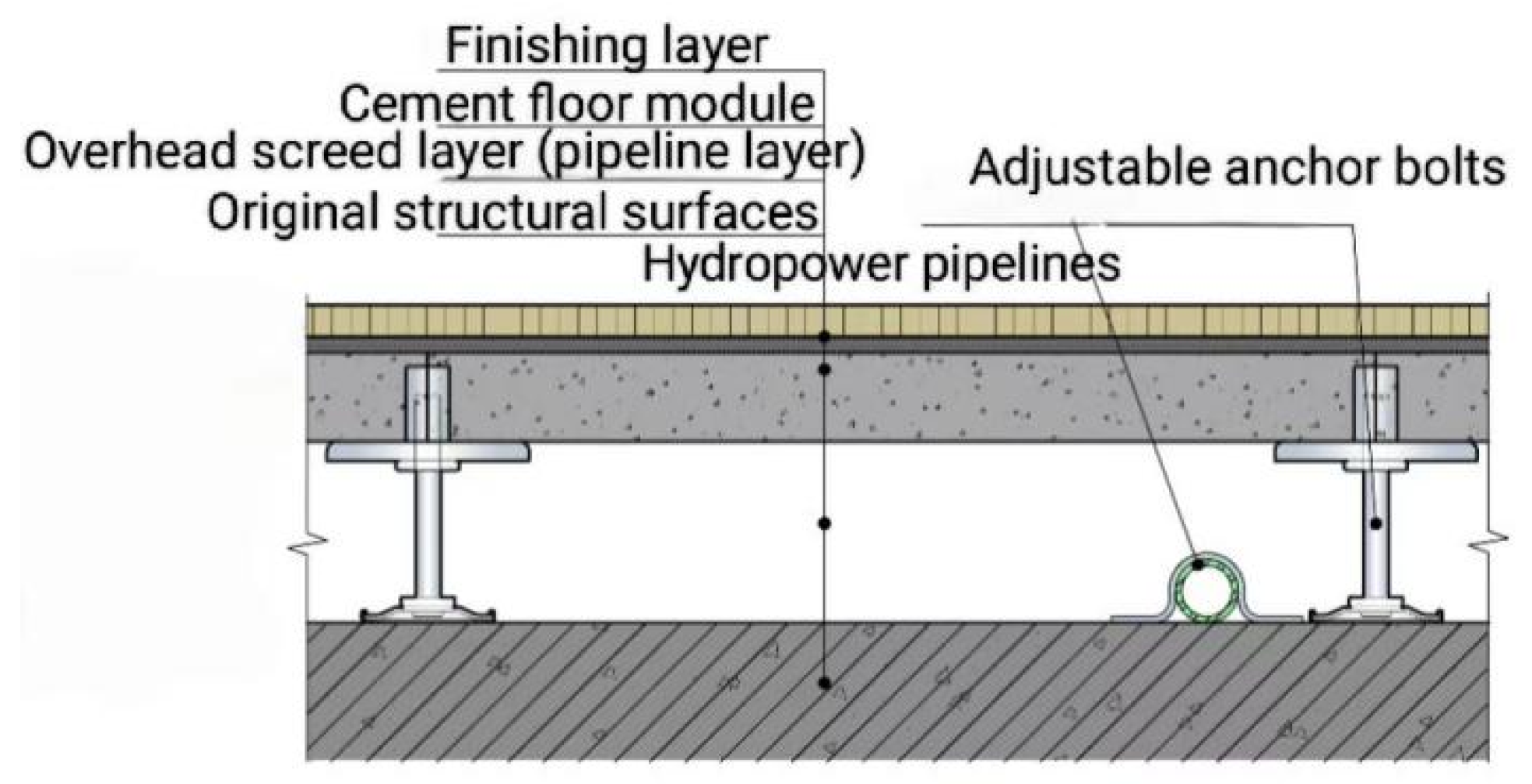
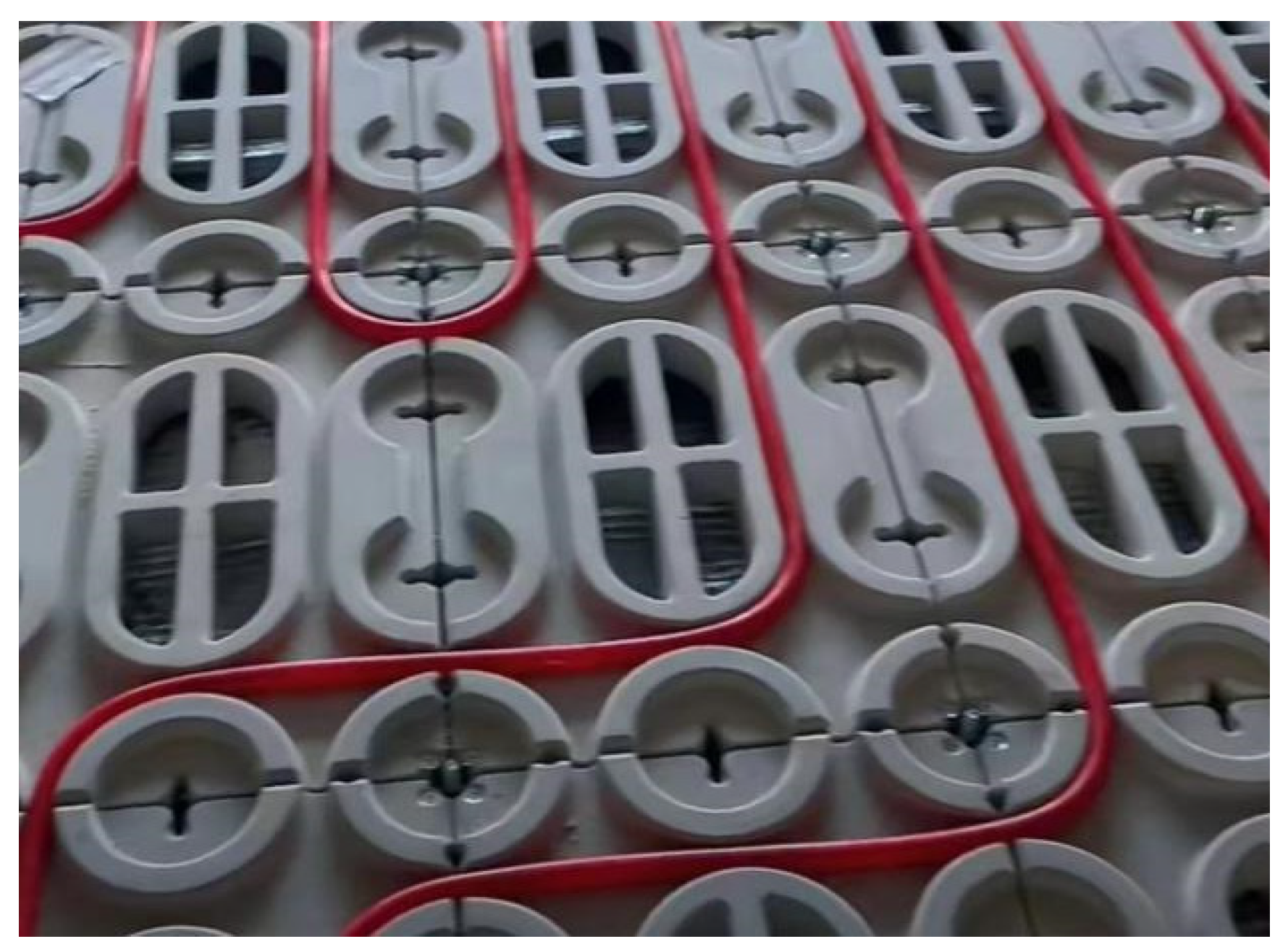

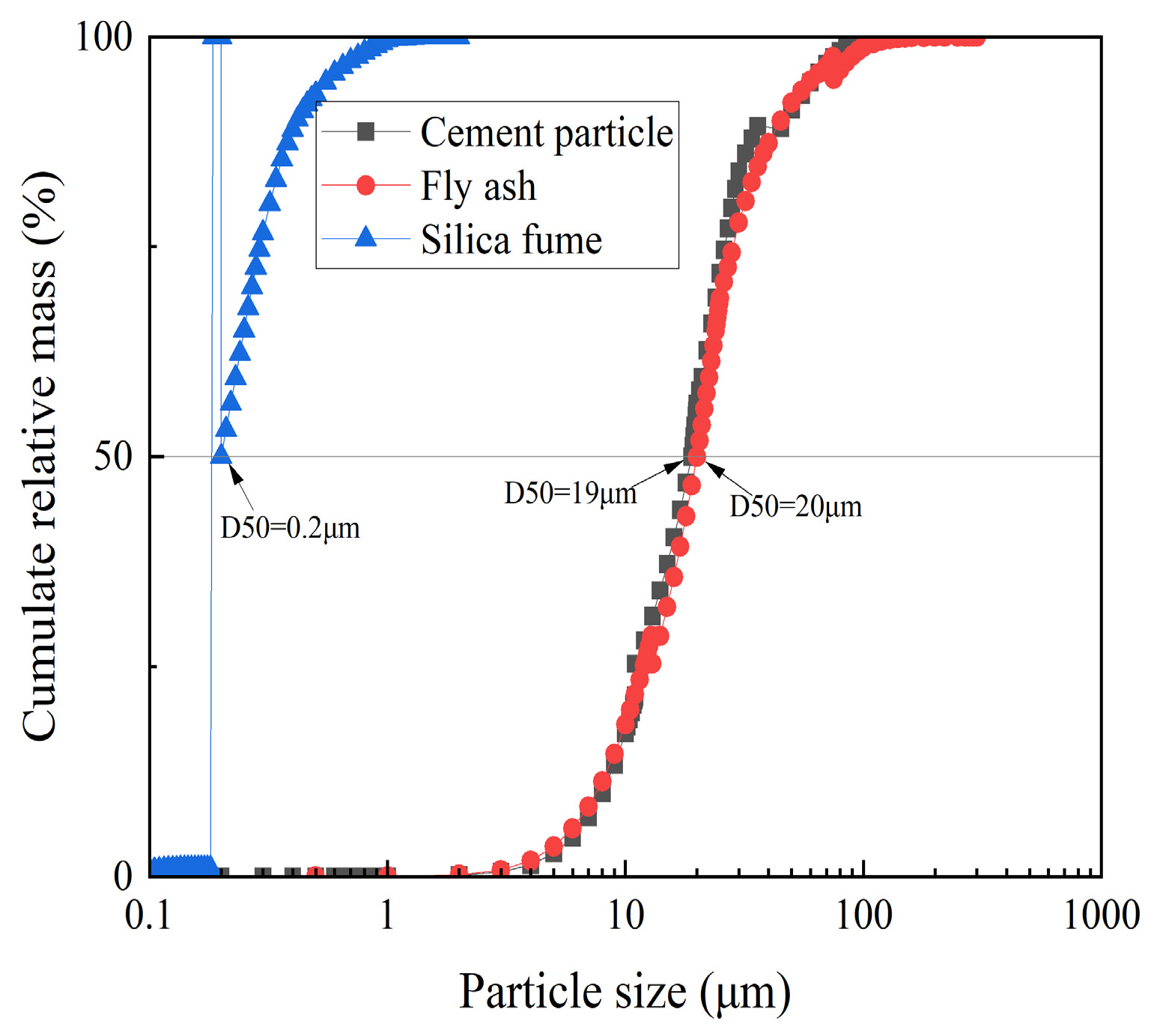

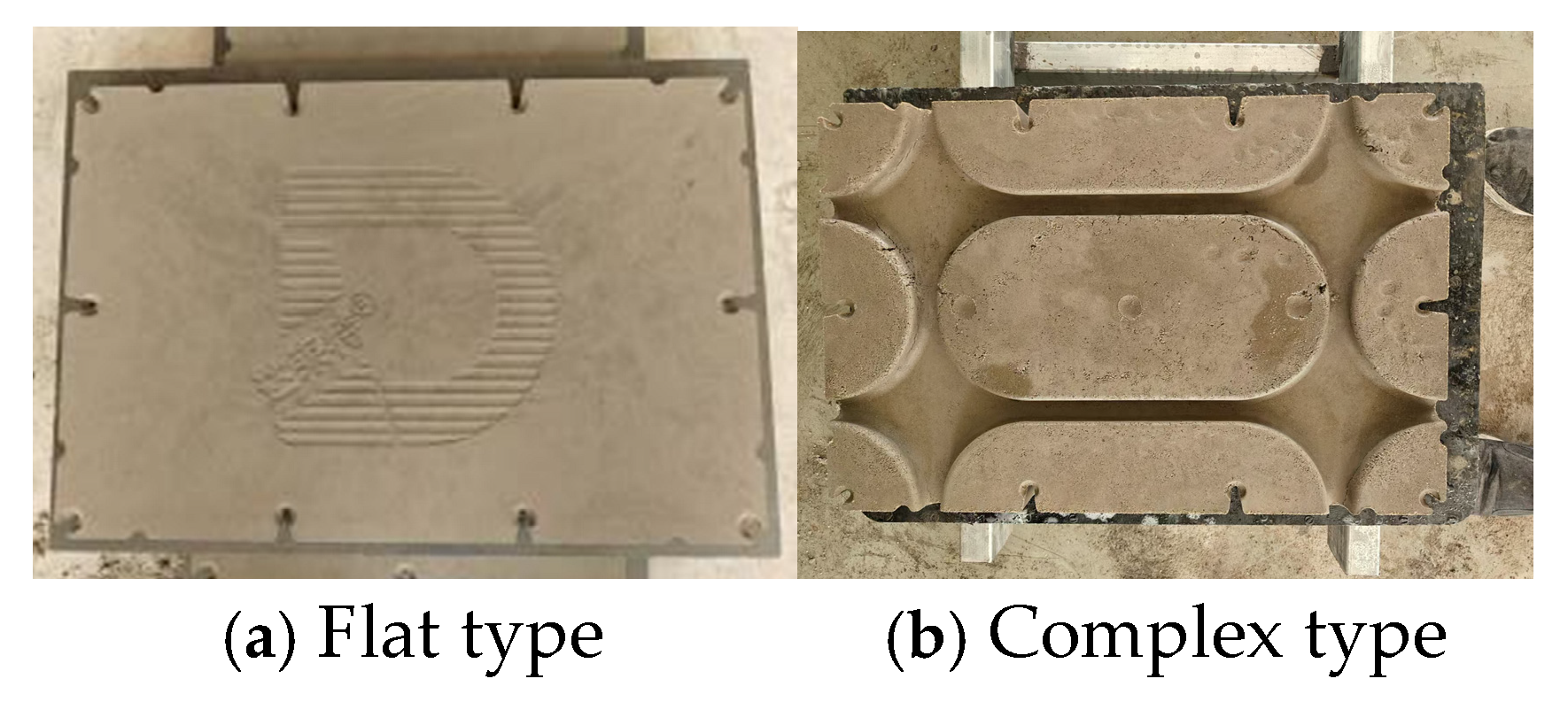
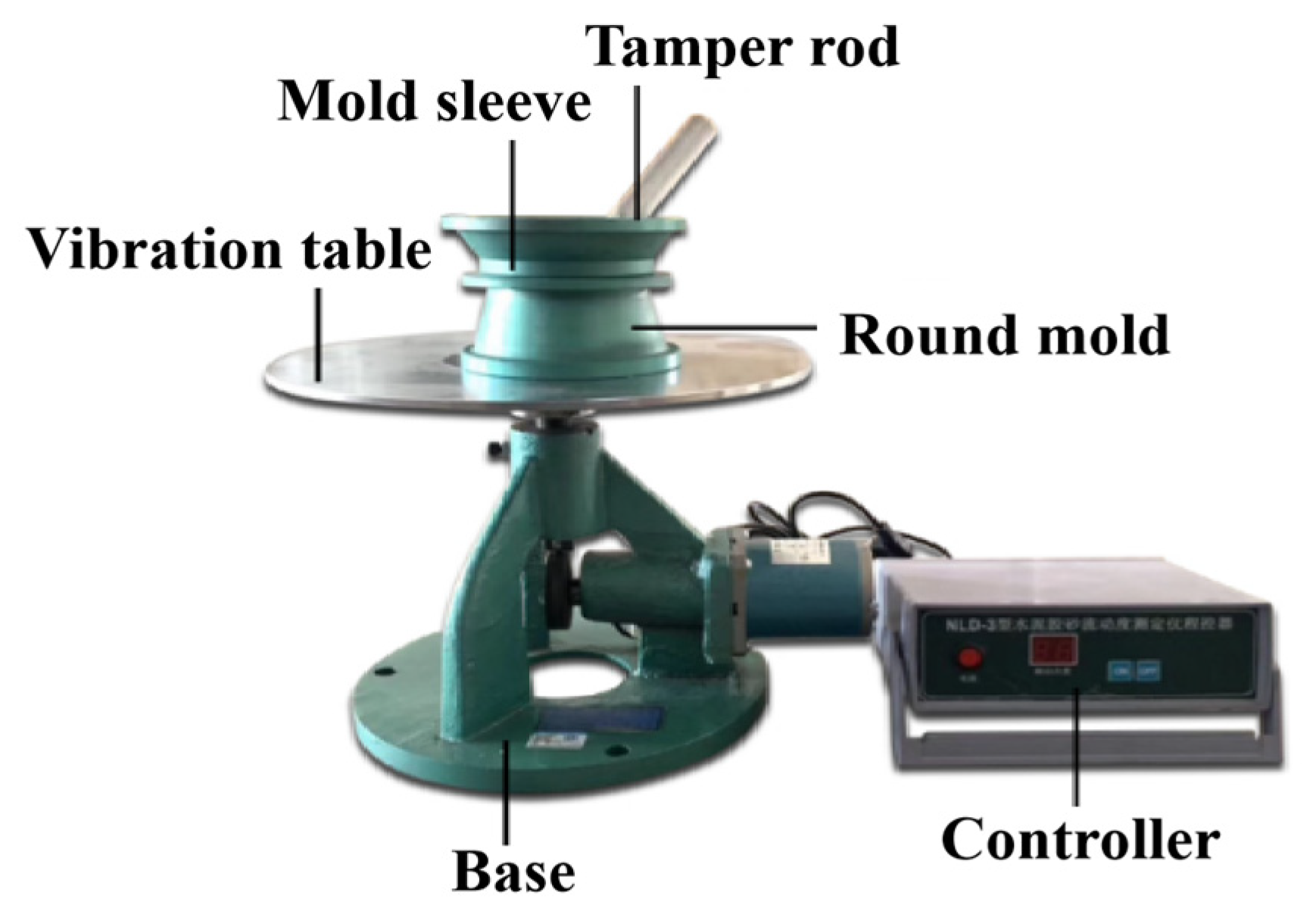
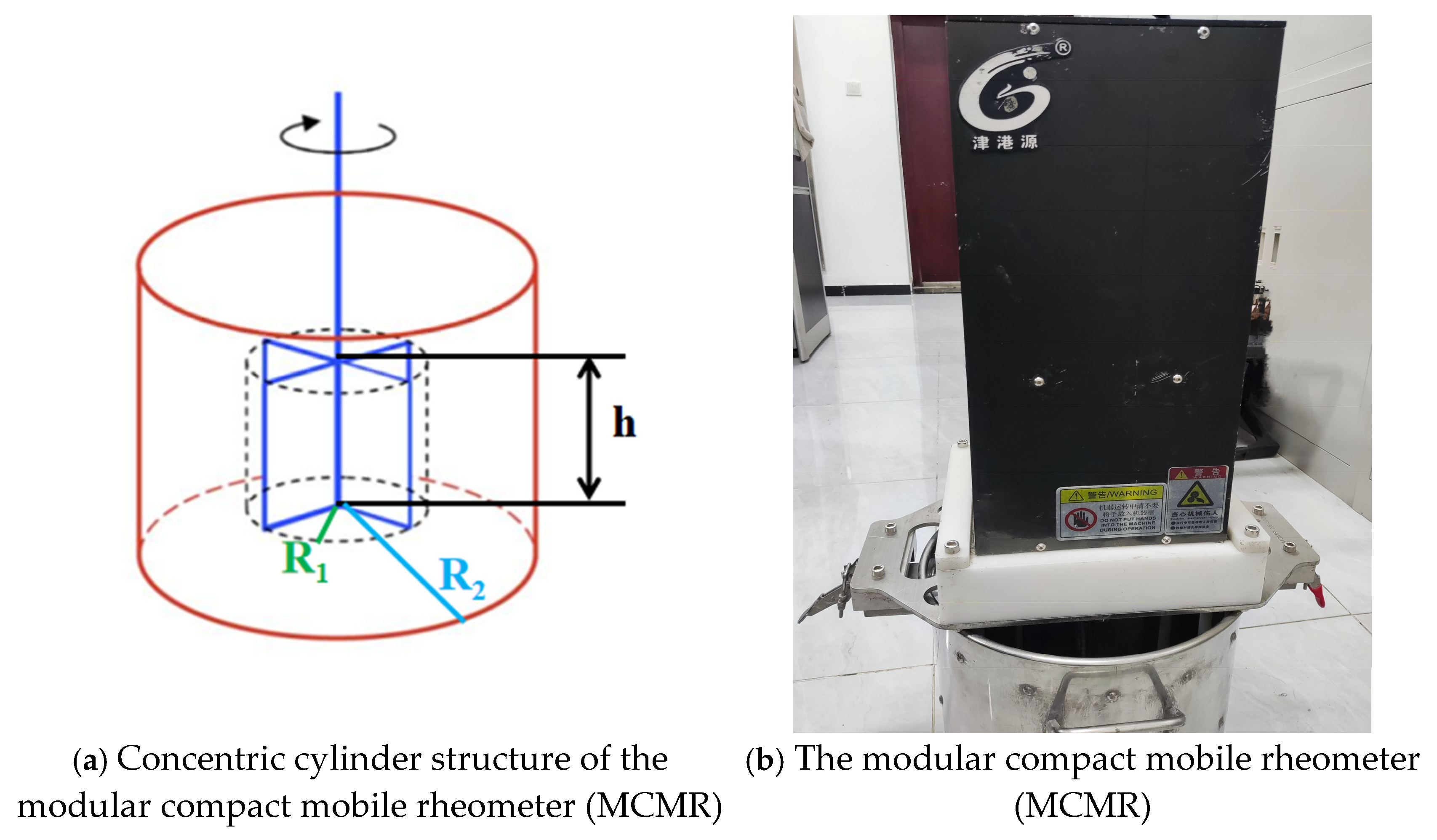
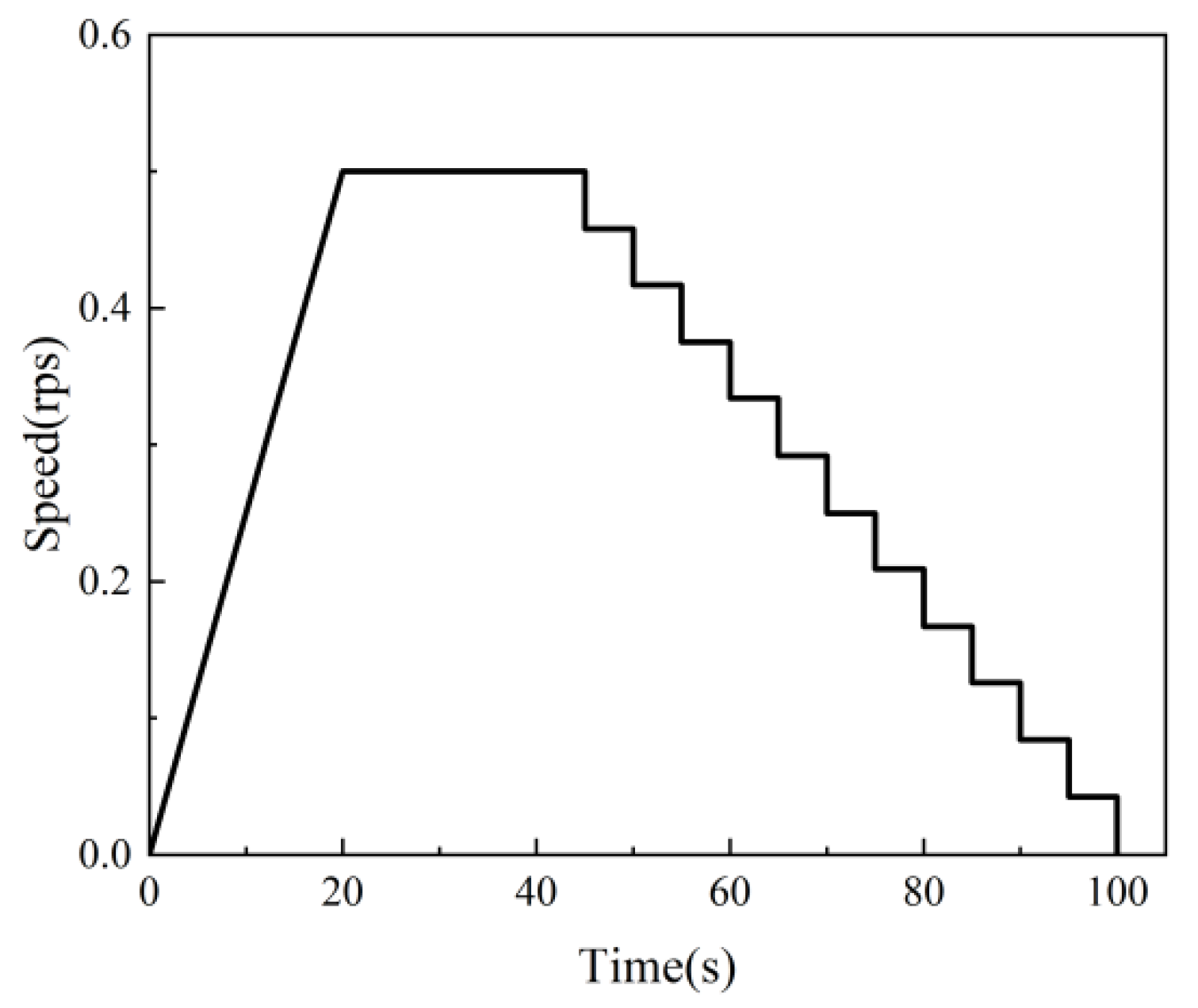

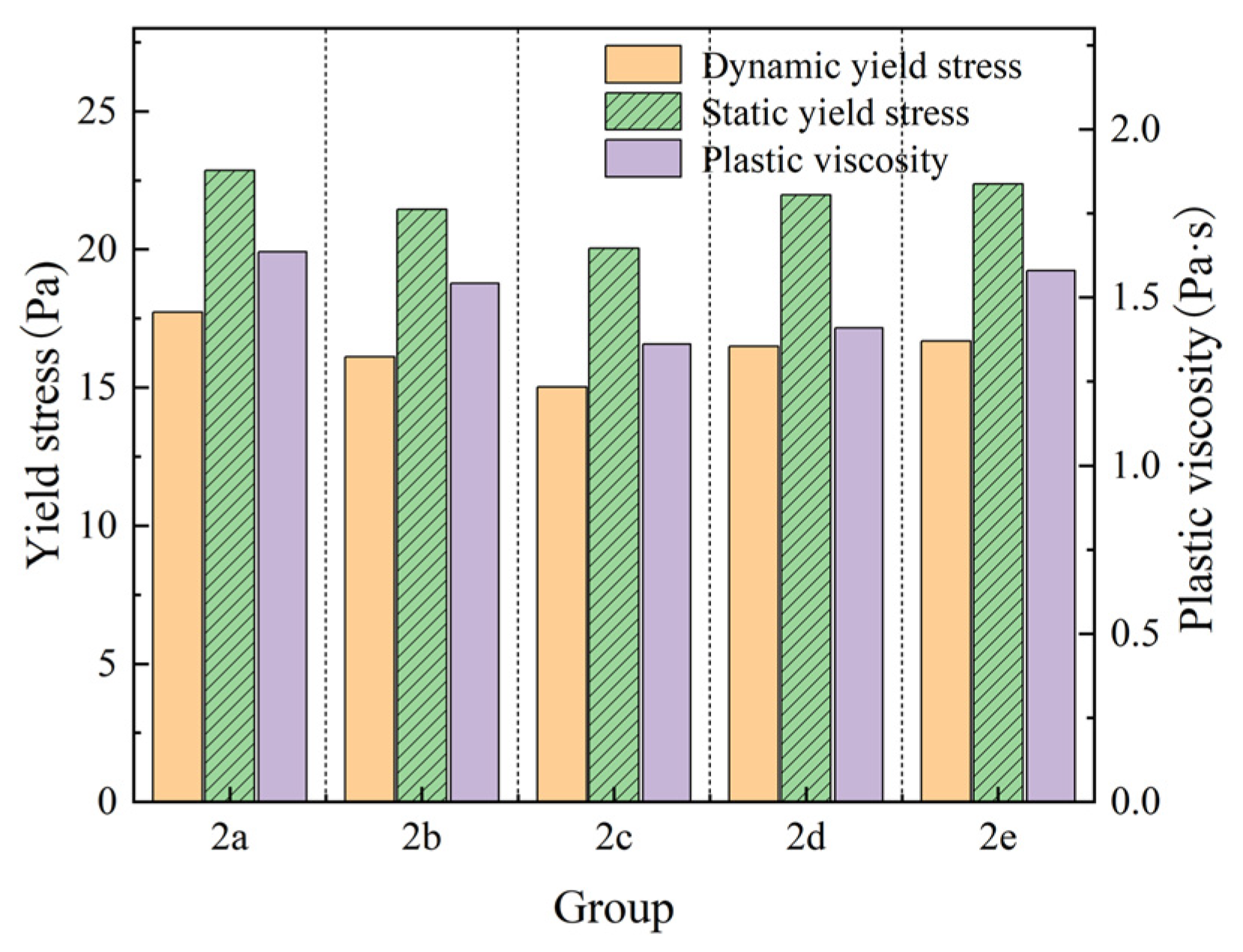

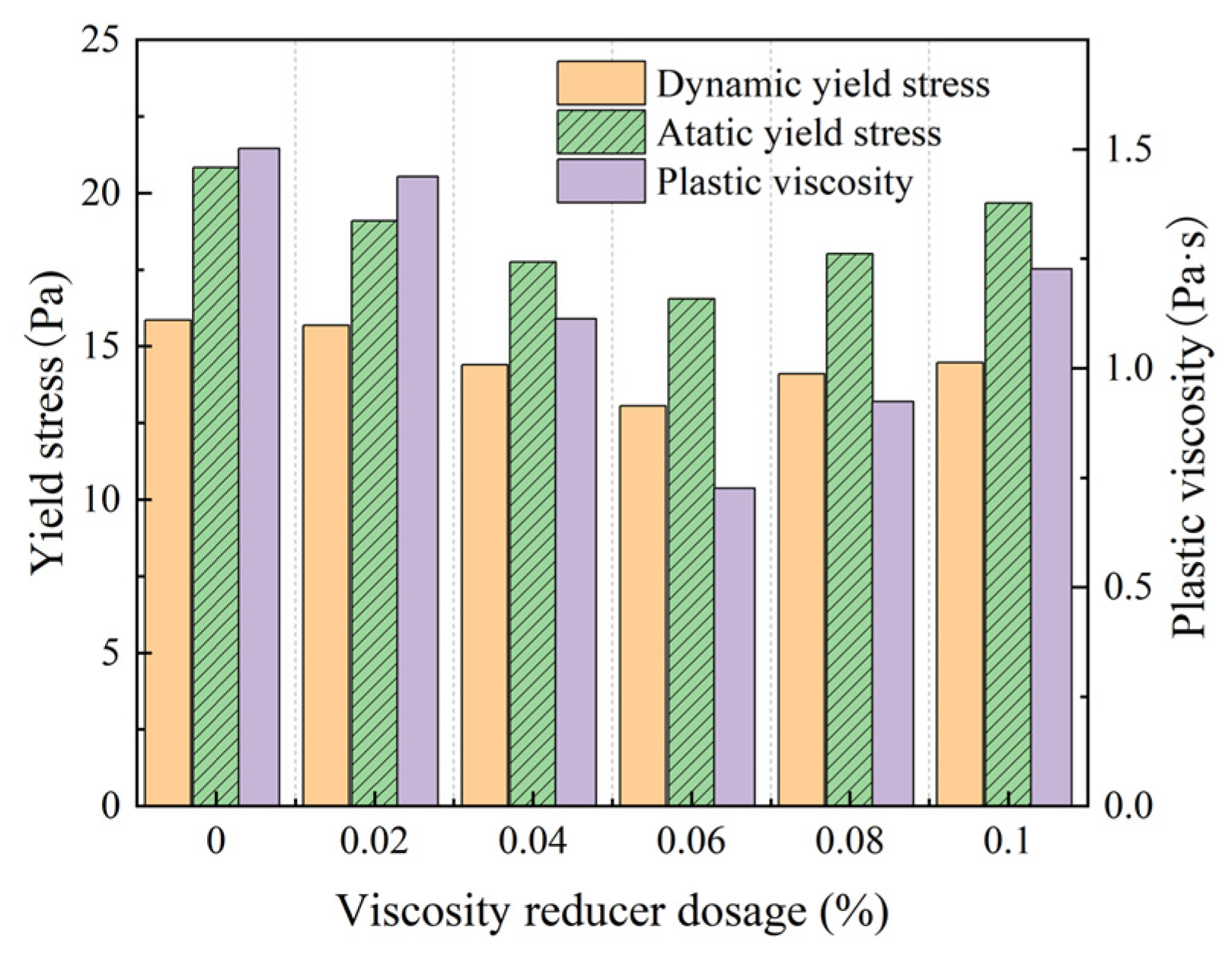

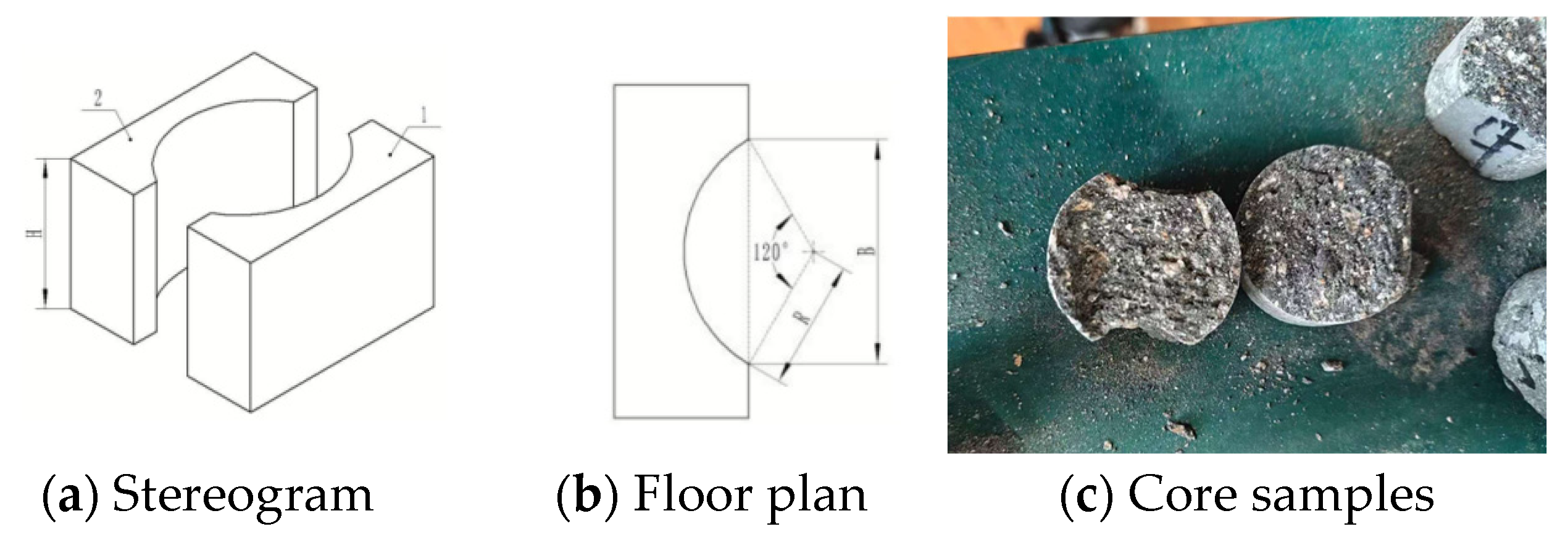
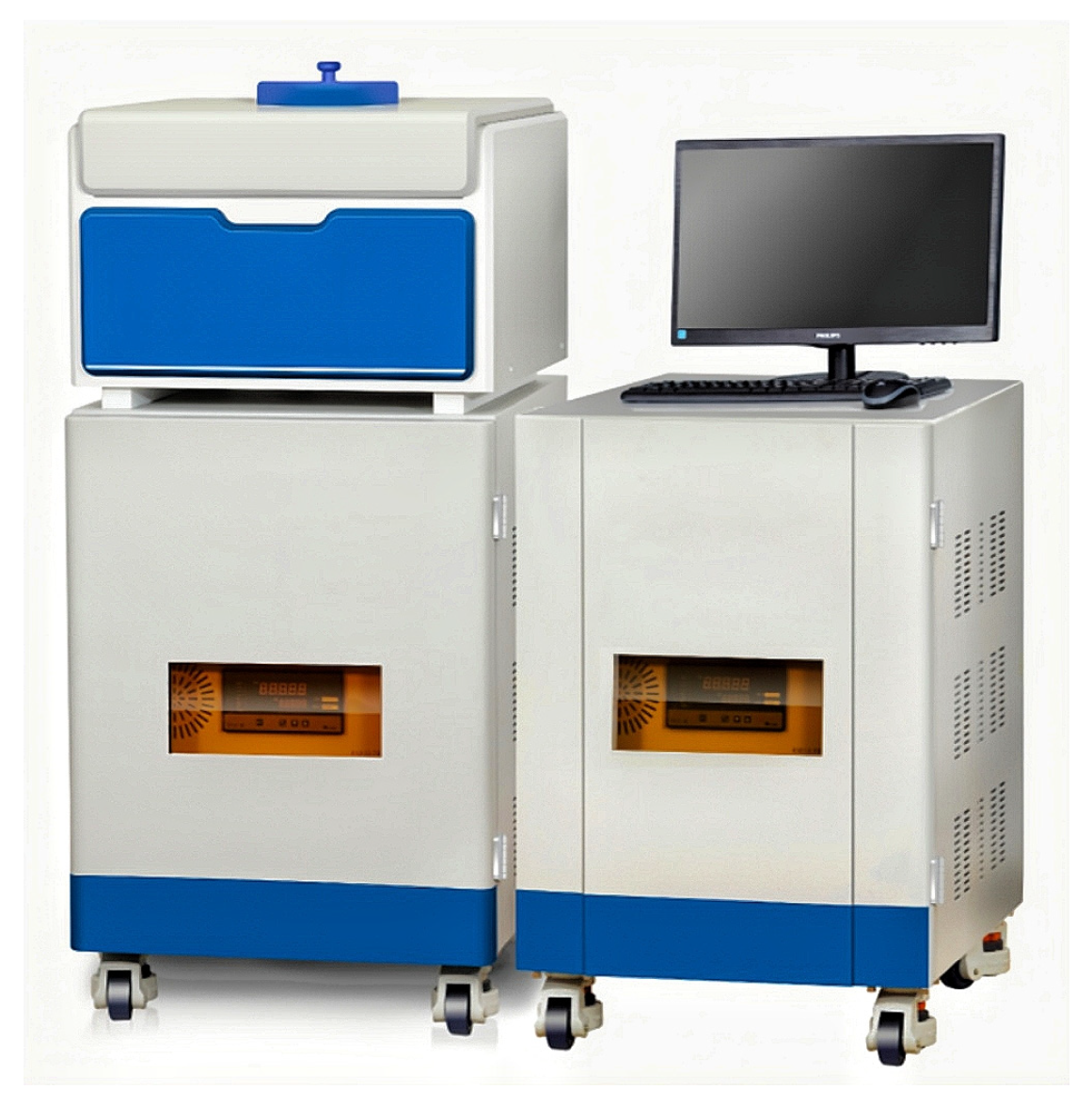
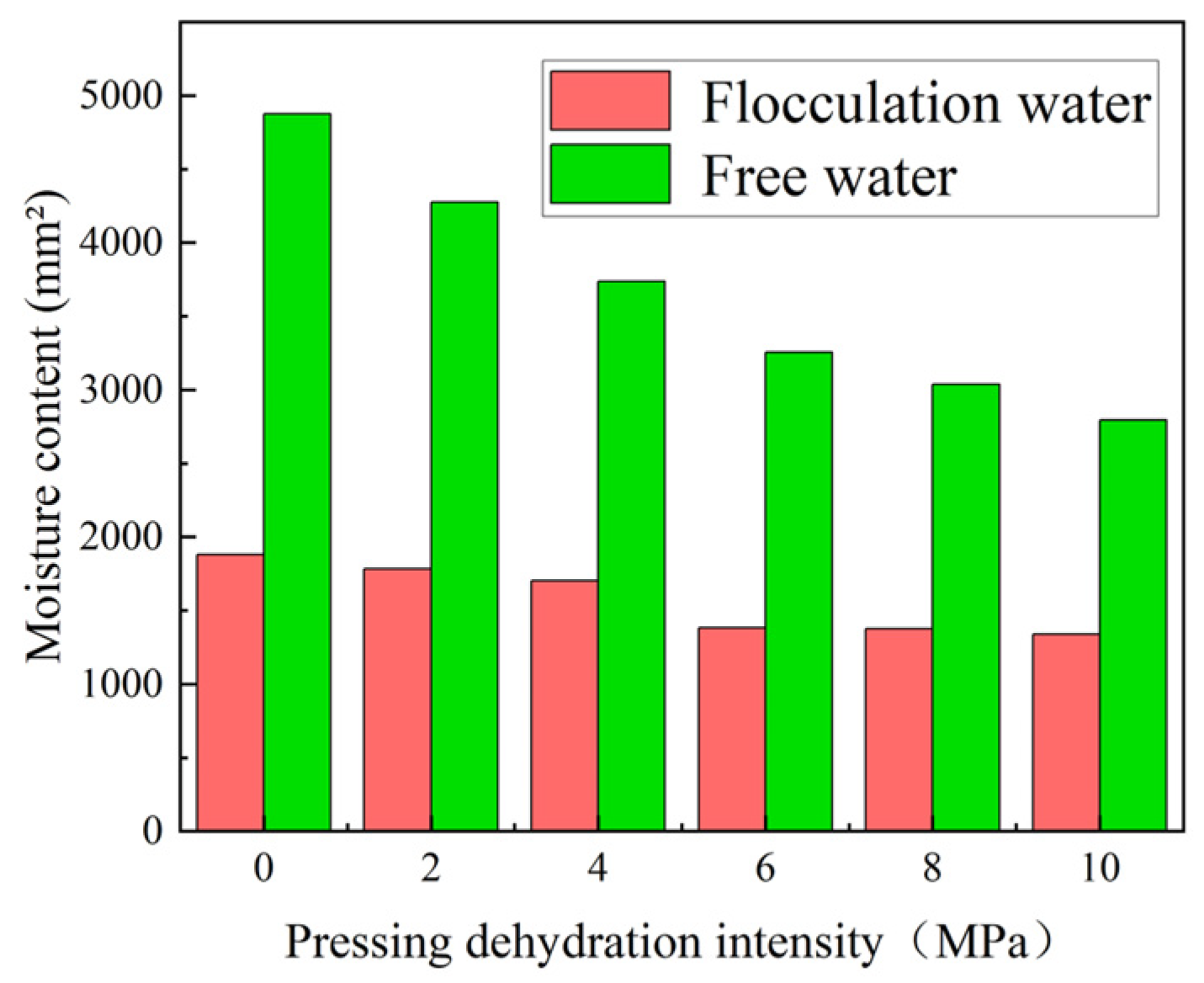
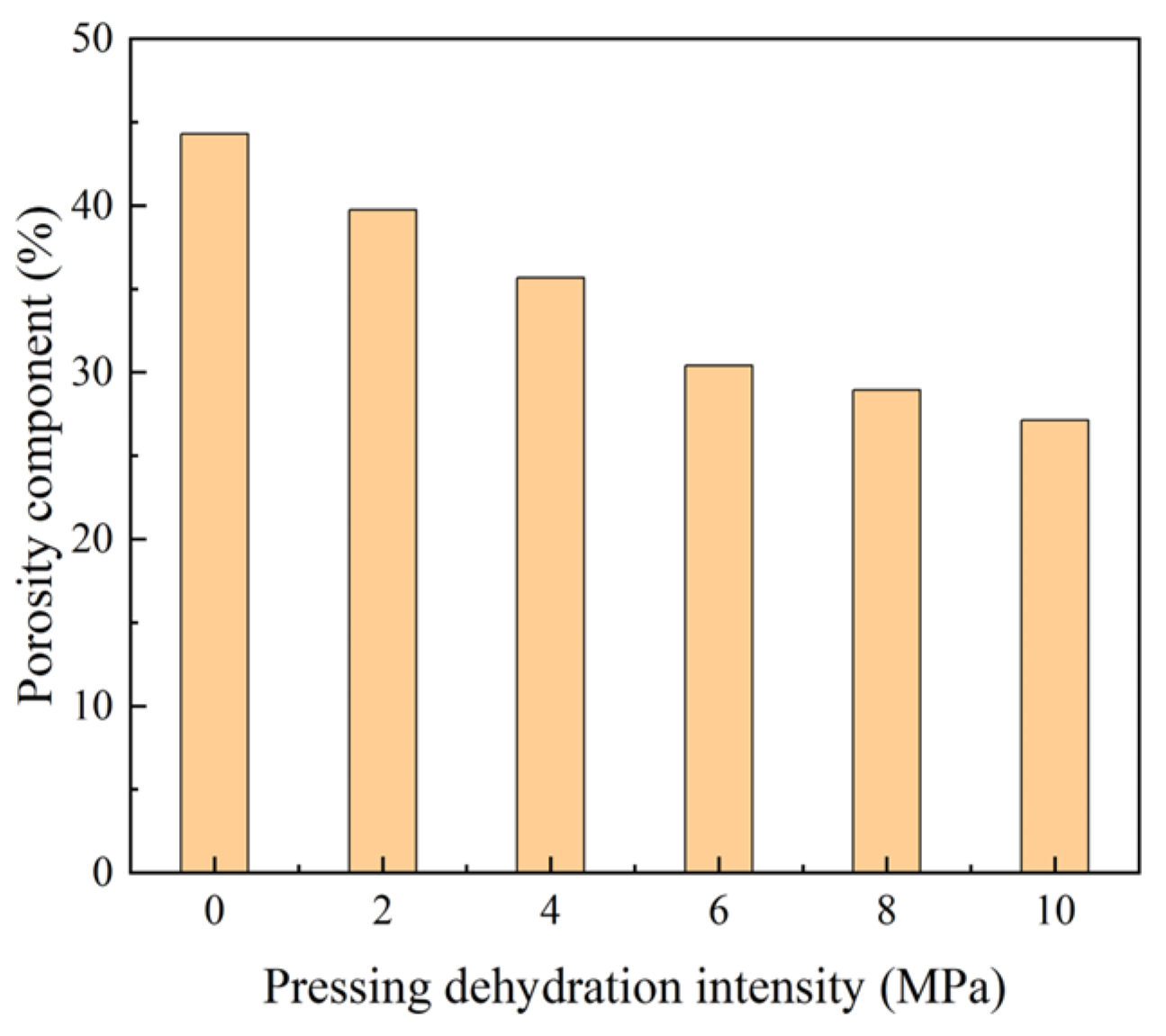


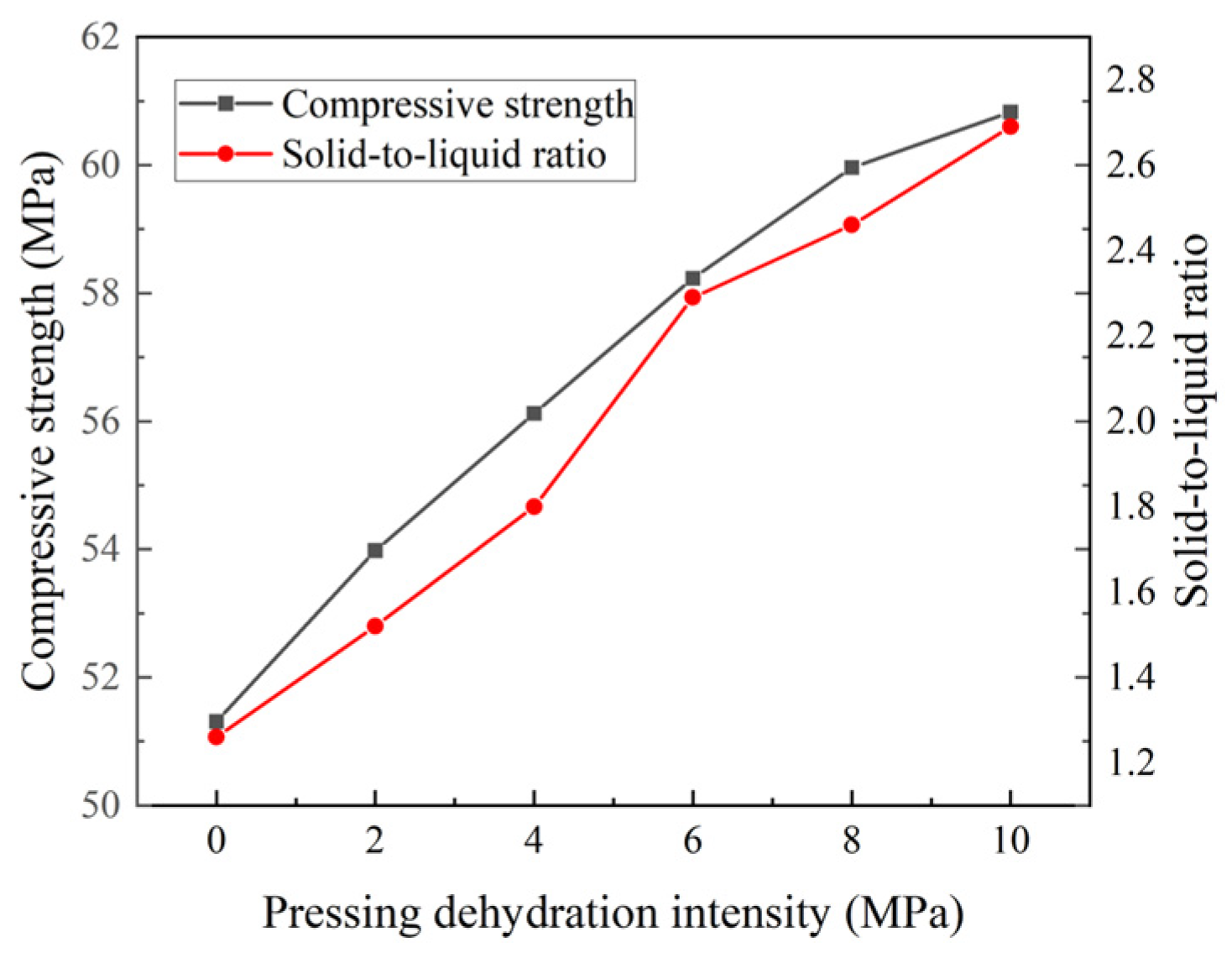
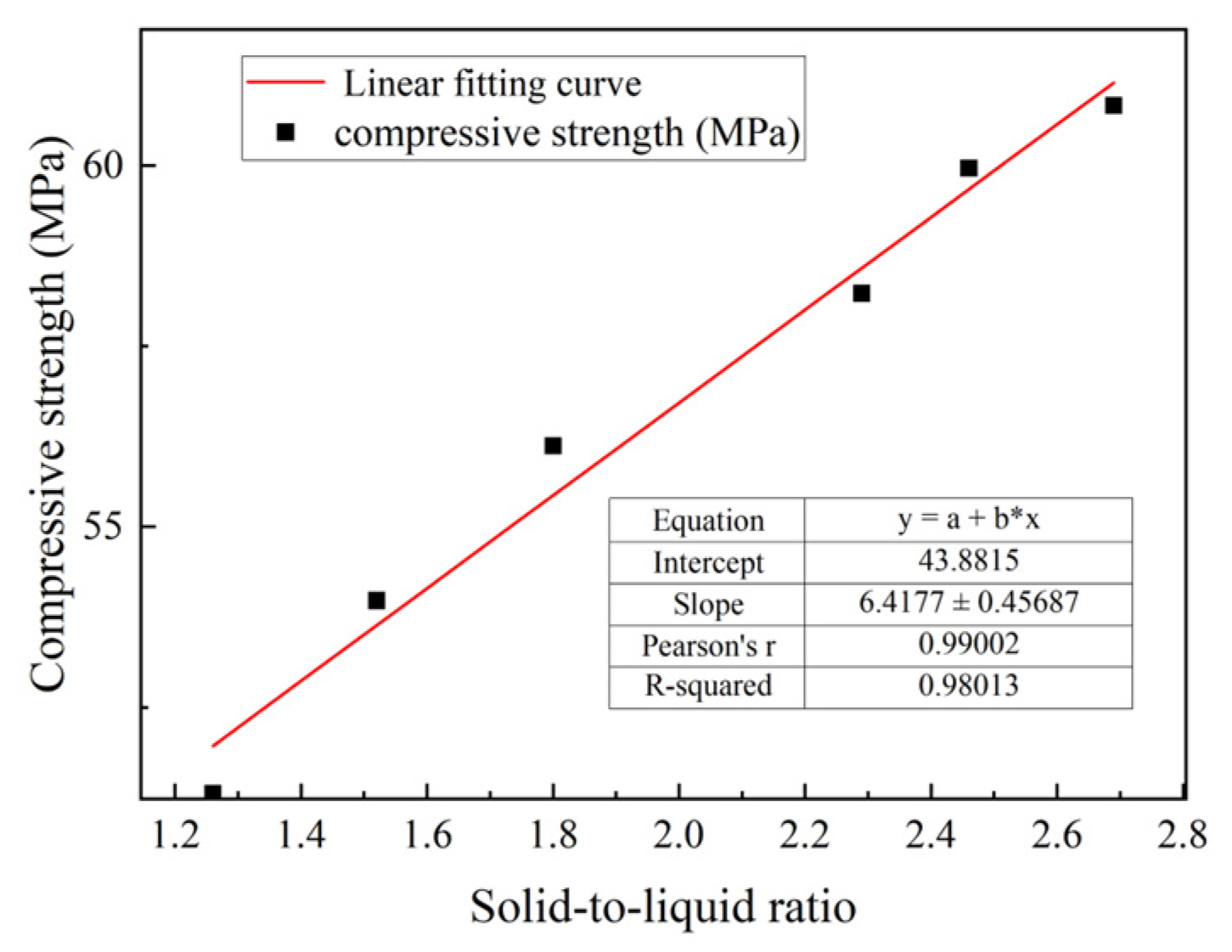
| Project Material | CaO | SiO2 | Al2O3 | Fe2O3 | MgO | SO3 | K2O | Loss |
|---|---|---|---|---|---|---|---|---|
| Cement | 57.71 | 23.43 | 7.93 | 2.94 | 3.16 | 2.09 | - | 2.74 |
| Fly ash | 4.85 | 54.46 | 26.56 | 5.16 | 0.46 | 1.24 | 3.48 | 3.79 |
| Silica fume | 0.23 | 96.85 | 0.41 | - | 0.33 | - | 0.23 | 1.95 |
| Design Strength Class | Cement (g) | Fly Ash (g) | Fine Sand (g) | Coarse Sand (g) | Water (g) |
|---|---|---|---|---|---|
| C40 | 187 | 80 | 567 | 167 | 80 |
| C50 | 233 | 100 | 500 | 167 | 100 |
| C60 | 267 | 100 | 400 | 233 | 100 |
| Design Strength Class | C40 | C50 | C60 | Standard Requirement (mm) |
|---|---|---|---|---|
| Consistency (mm) | 11 | 13 | 14 | 30–100 |
| Extension (mm) | 113 | 115 | 118 | >180 |
| Design Strength Class | Peak Torque (N⋅m) | Static Yield Stress (Pa) | Dynamic Yield Stress (Pa) | Plastic Viscosity (Pa·s) |
|---|---|---|---|---|
| C40 | 77.07 | 24.565 | 19.684 | 1.734 |
| C50 | 80.91 | 26.756 | 21.062 | 2.061 |
| C60 | 86.61 | 29.584 | 25.931 | 2.398 |
| Experiment | Cement (g) | Sand (g) | Fly Ash (g) | Silica Fume (g) | Water (g) | Water Reducing Agent (%) | Viscosity Reducer (%) |
|---|---|---|---|---|---|---|---|
| 0 | 1000 | 2000 | 0 | 0 | 380 | 0 | 0 |
| 1a | 900 | 2000 | 100 | 0 | 380 | 0 | 0 |
| 1b | 800 | 2000 | 200 | 0 | 380 | 0 | 0 |
| 1c | 700 | 2000 | 300 | 0 | 380 | 0 | 0 |
| 2a | 700 | 2000 | 250 | 50 | 380 | 0 | 0 |
| 2b | 700 | 2000 | 200 | 100 | 380 | 0 | 0 |
| 2c | 700 | 2000 | 150 | 150 | 380 | 0 | 0 |
| 2d | 700 | 2000 | 100 | 200 | 380 | 0 | 0 |
| 2e | 700 | 2000 | 50 | 250 | 380 | 0 | 0 |
| 3a | 700 | 2000 | 100 | 200 | 380 | 1 | 0 |
| 3b | 700 | 2000 | 100 | 200 | 380 | 1.5 | 0 |
| 3c | 700 | 2000 | 100 | 200 | 380 | 2 | 0 |
| 4a | 700 | 2000 | 100 | 200 | 380 | 0 | 0.02 |
| 4b | 700 | 2000 | 100 | 200 | 380 | 0 | 0.04 |
| 4c | 700 | 2000 | 100 | 200 | 380 | 0 | 0.06 |
| 4d | 700 | 2000 | 100 | 200 | 380 | 0 | 0.08 |
| 4e | 700 | 2000 | 100 | 200 | 380 | 0 | 0.1 |
| Quality Grade | Static Yield Stress (τ0)/Pa | Dynamic Yield Stress (τ)/Pa | The Total Number of Defects (t) | The Total Area of Defects (a)/mm2 |
|---|---|---|---|---|
| Grade A | τ0 < 21.000 | τ < 16.000 | t ≤ 2 | a ≤ 5 |
| Grade B | 21.000 ≤ τ0 ≤ 24.000 | 16.000 ≤ τ ≤ 19.000 | t ≤ 4 | a ≤ 10 |
| Grade C | τ0 > 24.000 | τ > 19.000 | t ≤ 6 | a ≤ 20 |
| Design Strength Class | Compression and Dewatering Compressive Strength (MPa) | Unpressurised Dewatering Compressive Strength (MPa) | Percentage Increase in Intensity (%) | Average Percentage of Increase in Intensity (%) |
|---|---|---|---|---|
| C40 | 50.80 | 41.12 | 24 | 21 |
| 52.21 | 42.30 | 23 | ||
| 51.02 | 43.93 | 16 | ||
| C50 | 60.49 | 50.29 | 20 | 16 |
| 58.42 | 51.63 | 13 | ||
| 61.51 | 53.97 | 14 | ||
| C60 | 67.84 | 62.75 | 8 | 11 |
| 70.21 | 61.63 | 14 | ||
| 71.31 | 63.47 | 12 |
Disclaimer/Publisher’s Note: The statements, opinions and data contained in all publications are solely those of the individual author(s) and contributor(s) and not of MDPI and/or the editor(s). MDPI and/or the editor(s) disclaim responsibility for any injury to people or property resulting from any ideas, methods, instructions or products referred to in the content. |
© 2025 by the authors. Licensee MDPI, Basel, Switzerland. This article is an open access article distributed under the terms and conditions of the Creative Commons Attribution (CC BY) license (https://creativecommons.org/licenses/by/4.0/).
Share and Cite
Xia, C.; Ran, Q.; Zhang, X.; Wang, X. Compression Dewatering Forming: A Rheology-Driven Approach to Produce Complex-Shaped Prefabricated Cement Products. Materials 2025, 18, 1607. https://doi.org/10.3390/ma18071607
Xia C, Ran Q, Zhang X, Wang X. Compression Dewatering Forming: A Rheology-Driven Approach to Produce Complex-Shaped Prefabricated Cement Products. Materials. 2025; 18(7):1607. https://doi.org/10.3390/ma18071607
Chicago/Turabian StyleXia, Chunlei, Qianping Ran, Xiongfei Zhang, and Xiaorong Wang. 2025. "Compression Dewatering Forming: A Rheology-Driven Approach to Produce Complex-Shaped Prefabricated Cement Products" Materials 18, no. 7: 1607. https://doi.org/10.3390/ma18071607
APA StyleXia, C., Ran, Q., Zhang, X., & Wang, X. (2025). Compression Dewatering Forming: A Rheology-Driven Approach to Produce Complex-Shaped Prefabricated Cement Products. Materials, 18(7), 1607. https://doi.org/10.3390/ma18071607







